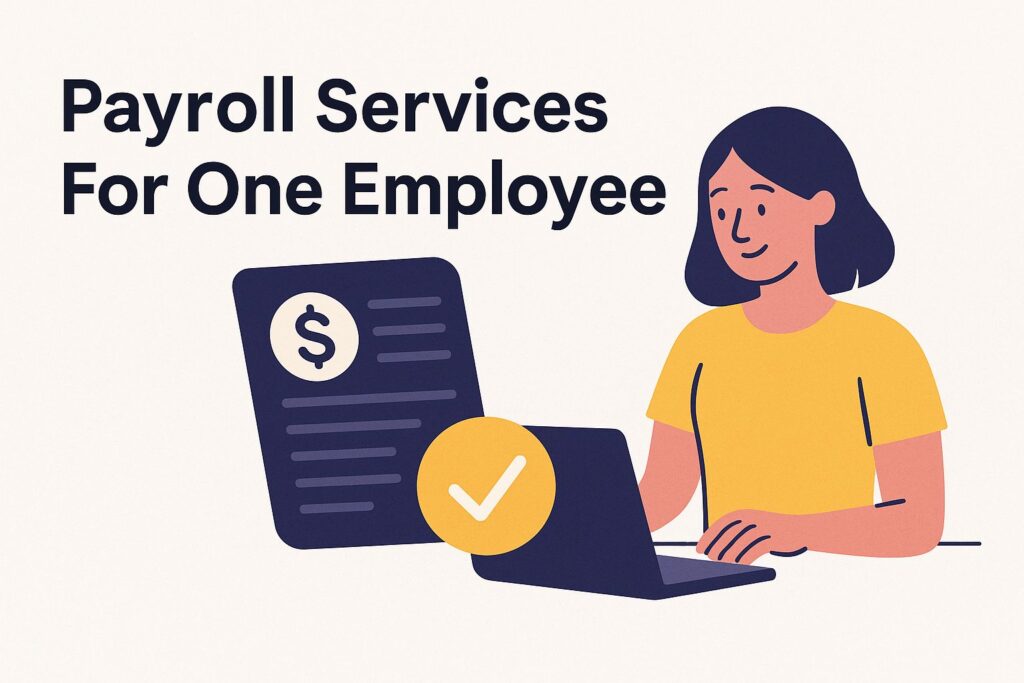
Payroll Services For One Employee
Most people are surprised to learn that you can have a robust outsource payroll service for a single employee for little is $25 a month. Handling payroll for a single worker may appear simple, but it comes with important duties. Knowing how payroll services work is important because they help follow legal rules and make payment processes easier. This article looks into the different payroll services you can choose, the advantages they provide, and the key steps for correctly setting up payroll. By examining the details, you’ll learn how to make your payroll process easier and avoid usual mistakes. Keep reading to learn how to manage payroll effectively.
Definition and Importance
Payroll services encompass all processes related to employee compensation, from wage calculation to tax compliance, essential for maintaining workforce satisfaction.
Utilizing reliable payroll services can significantly reduce errors, which, according to the IRS, affect 30% of small businesses and may lead to costly fines.
To achieve accurate results in payroll processing, you might want to use tools like Gusto to simplify tax rules and make paycheck management easier, or QuickBooks Payroll to connect better with accounting systems and handle payroll tasks automatically.
Intuit Online Payroll provides compliance updates, ensuring you remain aligned with state regulations and payroll management best practices. Using these services reduces mistakes and builds employee confidence in your payment systems.
Benefits of Using Payroll Services
Utilizing payroll services can save businesses up to 40 hours monthly by automating complex payroll calculations and ensuring tax compliance through effective payroll administration.
These services make tasks like tax withholding and payroll deductions for benefits easier by reducing mistakes and saving time on manual math.
Software like Gusto or ADP manages payroll and helps with tax filing and payroll consultation to prevent expensive penalties for businesses. For those interested in understanding the full capabilities and benefits of ADP, our ADP Software Review – Pros and Cons offers a deep dive into its features.
Payroll services often provide employee portals that improve satisfaction by enabling staff to handle their details and get their pay statements without hassle.
By integrating these tools, companies can focus more on core operations, elevating overall productivity.
Types of Payroll Services

Knowing about various payroll services and payroll service providers allows businesses to select the best option for their size and requirements. If you’re interested in exploring the top payroll solutions, our expert opinion on the 13 Best Payroll Outsourcing Companies in 2025 offers valuable insights.
Full-Service Payroll
Full-service payroll handles all tasks related to employee pay, including figuring out taxes and sending money directly to bank accounts. It’s perfect for companies that don’t have their own payroll specialists.
Companies such as ADP and Paychex simplify things by handling key duties like state and federal tax filing, which helps businesses follow the rules more easily.
They offer direct deposit, ensuring employees receive their pay on time without manual processing. At year-end, these platforms simplify reporting by automatically generating necessary forms like 1099s and W-2s, which reduces errors and saves time.
Businesses can choose plans based on employee count and specific needs, with options that scale as they grow.
Self-Service Payroll
Self-service payroll allows businesses to handle payroll tasks on their own with easy-to-use tools, often saving money.
To effectively implement self-service payroll, consider using tools like QuickBooks for a budget-friendly solution at just $25 per month.
Alternatives include Gusto, which offers customizable payroll schedules and benefits management. Think about choosing Paychex for its strong features designed for all sizes of businesses.
By using these platforms, businesses can easily handle employee records, manage deductions, and simplify tax calculations. This method cuts expenses, improves accuracy, and adheres to regulations, enabling your team to concentrate on growing the business rather than dealing with documents.
Choosing the Right Payroll Service
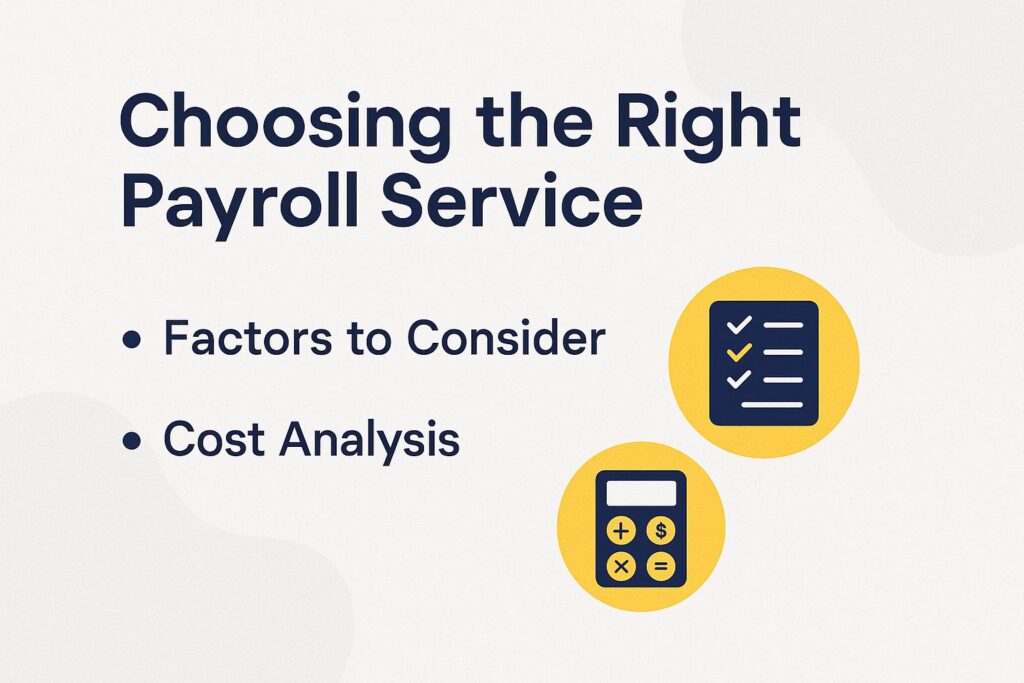
Choosing a payroll service depends on important elements such as the size of your company, your budget, and your payroll requirements. For medium-sized businesses, specific needs might arise that require tailored solutions. Worth exploring: Payroll Outsourcing For Medium Sized Businesses to better understand how to address these challenges.
Factors to Consider
Key factors to consider when choosing a payroll service include software integration, customer support, and compliance features.
First, make sure the payroll software works well with current HR tools such as BambooHR or Gusto.
Next, evaluate customer support-look for 24/7 availability to address potential issues. Confirm that the service complies with federal and state regulations to avoid costly penalties.
For example, Paychex offers various methods to link with different systems for payroll compatibility with accounting programs and is known for excellent customer support, making it a solid option for businesses needing reliable assistance to comply with regulations.
Cost Analysis
Knowing how much payroll services cost is important for budgeting. Software prices can range from $20 to $500 per month, based on the features they include.
Basic services often offer direct deposit and tax calculations for around $20-$50 each month, which suits small businesses with simple requirements.
Complete service packages, priced from $100 to $500, include features such as payroll tax filing and portals for employees to manage their own information. For example, ADP’s basic plan costs about $149 per month and includes strong customer support and reporting tools.
Analyzing your company size and payroll complexity will help identify the best option, maximizing value while minimizing unnecessary expenses.
Setting Up Payroll for One Employee
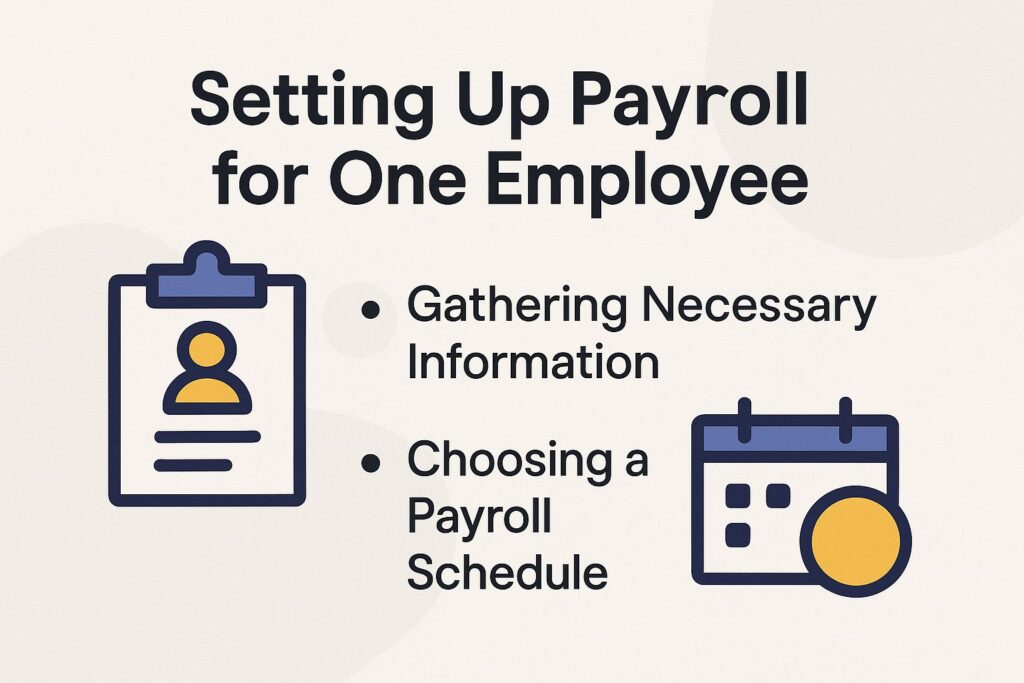
Setting up payroll for one employee requires gathering necessary details and choosing a payment schedule that follows the law.
Gathering Necessary Information
To set up payroll, gather essential information including employee name, address, Social Security number, and pay rate.
Make sure you have all the required documents ready. These include the:
- W-4 form for tax withholding
- I-9 for verifying employment eligibility
- Direct deposit form to facilitate smooth payment transfers
Using digital forms can improve efficiency, allowing for faster processing and easy access.
Once you have collected all the necessary details, use payroll software like QuickBooks or Gusto to simplify calculations, tax filings, and payments. This helps you comply with legal requirements and save time on administrative tasks.
Choosing a Payroll Schedule
Choosing the right payroll schedule is important for following rules and keeping employees happy. People often choose to pay each week, every other week, or once a month.
Each schedule has its pros and cons. Weekly pay offers quick cash flow for employees but can increase administrative costs due to processing time.
Bi-weekly is the most popular option, striking a balance between efficient administration and employee satisfaction. This method often aligns well with monthly bills, helping staff budget more effectively.
Monthly pay simplifies payroll processing and reduces costs but can lead to cash flow issues for employees waiting longer for their wages. When deciding, consider your company’s size, industry practices, and employee preferences.
Compliance and Regulations
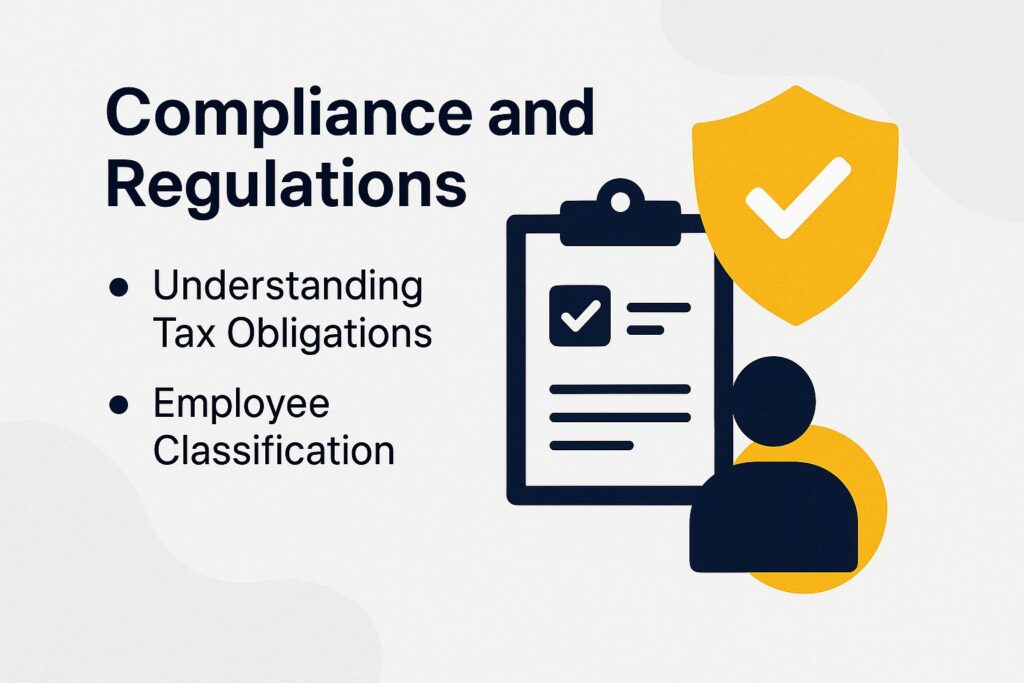
Following payroll rules is necessary to avoid penalties and treat employees fairly under labor laws. This approach aligns with the principles outlined in our analysis of 7 Payroll Errors That Could Be Costing You Money, highlighting common pitfalls to avoid.
Understanding Tax Obligations
Employers are required to withhold various taxes from employee wages, including federal income tax, Social Security, and Medicare.
Federal income tax withholding ranges from 10% to 37%, depending on the employee’s tax bracket.
Employers should refer to the IRS Publication 15-T for current withholding tables. Social Security tax is set at 6.2% of wages up to a designated limit, while Medicare tax is 1.45% on all wages, with an additional 0.9% for high earners.
For exact calculations and safe payroll handling, employers should check the IRS website for the most recent rates and required forms.
Employee Classification
Correctly classifying employees as either W-2 employees or 1099 contractors is critical for compliance and tax accuracy.
To correctly categorize employees, look at the following factors:
- W-2 employees typically have set hours and receive consistent paychecks.
- 1099 contractors operate independently, set their hours, and invoice for completed work.
To prevent mistakes in classification, use tools like IRS Form SS-8, which helps figure out the correct status. Misclassifying workers can lead to fines, back taxes, and legal problems. It’s important to talk to tax professionals or employment lawyers to follow the rules and lower the risks of this choice.
Managing Payroll Records
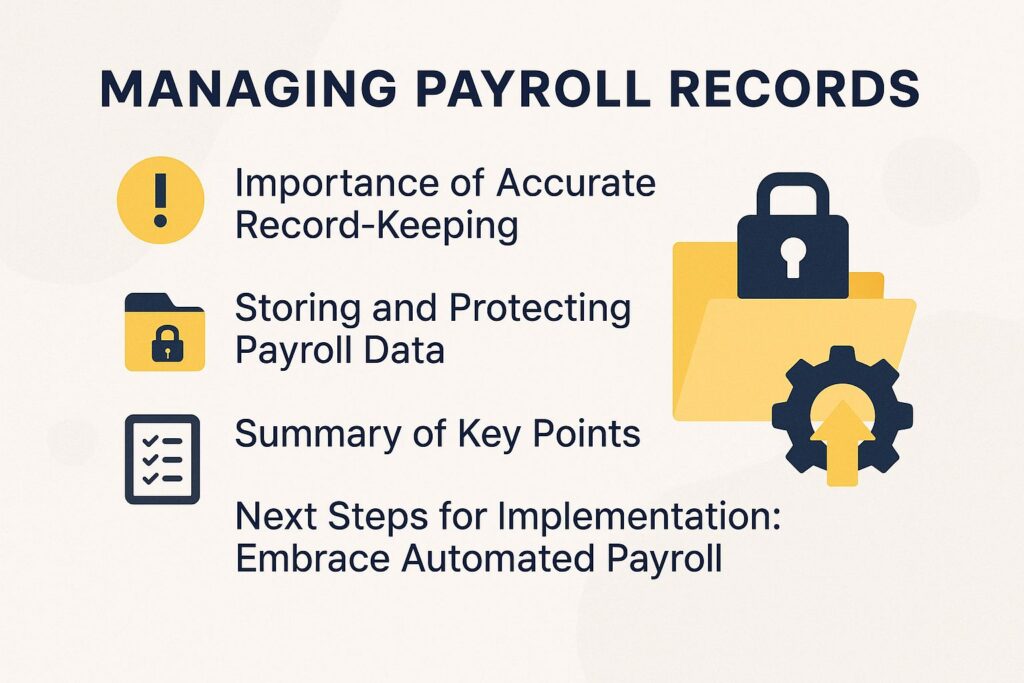
Good management and correct record-keeping of payroll files are important for audits and keeping employee confidence. Related insight: 7 Payroll Errors That Could Be Costing You Money can highlight common pitfalls to avoid.
Importance of Accurate Record-Keeping
Maintaining correct payroll records helps businesses avoid IRS penalties and comply with labor laws.
Setting up a clear payroll record-keeping plan means using special software like QuickBooks or Gusto. These tools handle the math for you and keep exact records of the hours employees work.
Using QuickBooks, a company can simplify payroll and keep accurate records of employee hours, pay, and deductions.
Reviewing records every three months helps keep them up-to-date and ensures they meet rules and payroll checks. This proactive method helps with audits and builds employee trust by ensuring they feel secure about their payments, which leads to a better workplace environment.
Storing and Protecting Payroll Data
It’s important to protect payroll information to prevent identity theft and comply with data protection laws.
To improve data safety in payroll data management, consider using cloud payroll services like Paychex or Gusto that provide encrypted data storage and frequent security updates.
Implement strict access controls by setting permissions that limit employee access to only their relevant data, ensuring compliance with laws like GDPR and HIPAA. Use payroll security methods to protect employee details.
Establish a routine for backing up data, using services such as Backblaze or Carbonite, to prevent loss in case of data breaches. Think about using payroll outsourcing to improve how you handle data.
Regularly checking your data protection measures will strengthen your security plan and verify that payroll compliance services are functioning correctly.
Summary of Key Points
Important points are following rules, picking a suitable payroll service, and keeping records correct, including employee record-keeping for accuracy.
Staying informed about local, state, and federal rules is essential for following payroll regulations. This can be achieved by subscribing to resources like the IRS updates or local chamber of commerce newsletters.
When choosing a payroll service, look for features such as automatic tax calculations, direct deposit capabilities, and easy-to-use interfaces. Make sure the service includes payroll check processing and features for employees to handle tasks themselves. Popular choices include:
- Gusto for small businesses, offering payroll solutions for startups
- ADP offers HR payroll services designed for bigger companies.
Keeping accurate records is important; use accounting software like QuickBooks or Xero to review payroll entries each month and make sure payroll accounting is accurate, which helps avoid mistakes during audits.
Upcoming Actions for Setup: Start Using Automated Payroll
To manage payroll effectively, pick the right service, keep accurate records, and comply with all rules and regulations, including changes to payroll frequency.
Start by looking into well-known payroll services like Gusto, Paychex, or ADP. Compare details such as how easy they are to use, their costs, and the help they provide with payroll tasks.
Once you select a service, set up a schedule for payroll, incorporating real-time payroll processing. Note important dates for paying employees, sending tax forms, and complying with regulations to make sure everything is done on time.
Teach employees about payroll processes, such as accessing pay stubs and handling deductions, using payroll training resources. This basic work will make your payroll process easier and keep you within labor law requirements.
About the Author
Kim Anderson is a Harvard University graduate with a bachelor’s degree in Accounting and Finance. She’s the owner of a successful payroll outsourcing firm based in California and a contributing writer for My Payroll Outsourcing. With 14 years of experience, Kim helps businesses streamline compliance, minimize administrative risk, and manage multi-state workforces with confidence.

